A Selection of High Redshift Galaxy Press Releases and Articles
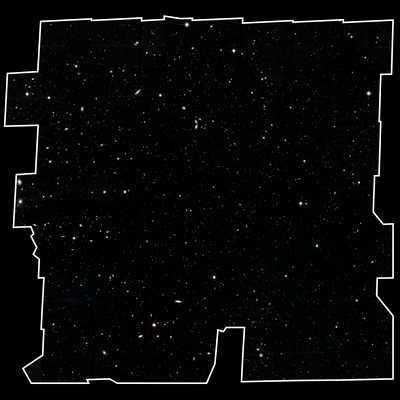
Hubble Astronomers Assemble Wide View of the Evolving Universe
Hubblesite
2 May 2019
How far is far? And, how do you know when you get there? In 1995, astronomers decided to use the Hubble Space Telescope to conduct a bold and daring experiment to address this puzzle. For 10 consecutive days, Hubble stared at one tiny, seemingly empty patch of sky for 1 million seconds.
The gamble of precious telescope time paid off. Hubble captured the feeble glow of myriad never-before-seen galaxies. Many of the galaxies are so far away it has taken billions of years for their light to reach us. Therefore, the view is like looking down a "time corridor," where galaxies can be seen as they looked billions of years ago. Hubble became astronomy's ultimate time machine.
The resulting landmark image is called the Hubble Deep Field. At the time, the image won the gold medal for being the farthest peek into the universe ever made. Its stunning success encouraged astronomers to pursue a series of Hubble deep-field surveys. The succeeding surveys uncovered more galaxies at greater distance from Earth, thanks to new cameras installed on Hubble during astronaut servicing missions. The cameras increased the telescope's power to look even deeper into the universe.
more
Earliest galaxies in the universe spin like the Milky Way
UCSC Press Release
10 January 2018
Astronomers looking back to a time soon after the big bang have discovered swirling gas in some of the earliest galaxies to have formed in the universe. These newborn galaxies, observed as they appeared nearly 13 billion years ago, spin like a whirlpool, similar to our own Milky Way galaxy.
Garth Illingworth, professor emeritus of astronomy and astrophysics at UC Santa Cruz and a member of the international team that made the discovery, explained that light from distant objects takes time to reach Earth, so observing objects that are billions of light years away enables astronomers to look back in time and directly observe the formation of the earliest galaxies.
more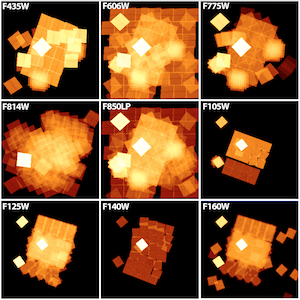
The GOODS-S/CDF-S Hubble Legacy Field (HLF)
MAST Newsletter
1 september 2016
The Hubble Legacy Fields project has released a combined dataset of more than 7000 HST images of the GOODS-S/CDF-S region.
more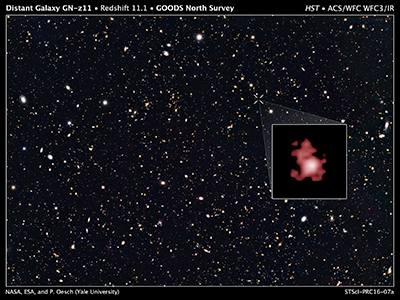
Hubble Team Breaks Cosmic Distance Record
HubbleSite
3 march 2016
NASA's Hubble Space Telescope is an amazing time machine; by looking back through space, astronomers actually look back through time. Now, by pushing Hubble to its limits, an international team of astronomers has shattered the cosmic distance record by viewing the farthest galaxy ever seen. Named GN-z11, this surprisingly bright, infant galaxy is seen as it was 13.4 billion years in the past. The astronomers saw it as it existed just 400 million years after the big bang, when the universe was only three percent of its current age. At a spectroscopically confirmed redshift of 11.1, the galaxy is even farther away than originally thought. It existed only 200 million to 300 million years after the time when scientists believe the very first stars started to form. At a billion solar masses, it is producing stars surprisingly quickly for such an early time. This new record will most likely stand until the launch of Hubble's successor, the James Webb Space Telescope, which will look even deeper into the universe for early galaxies.
more
NASA Great Observatories Team Up to Discover Ultra-Bright Young Galaxies
HubbleSite
7 january 2014
NASA's Hubble Space Telescope and Spitzer Space Telescope joined forces to discover and characterize four unusually bright galaxies as they appeared more than 13 billion years ago, just 500 million years after the big bang. Although Hubble has previously identified galaxies at this early epoch, astronomers were surprised to find objects that are about 10 to 20 times more luminous than anything seen previously.
more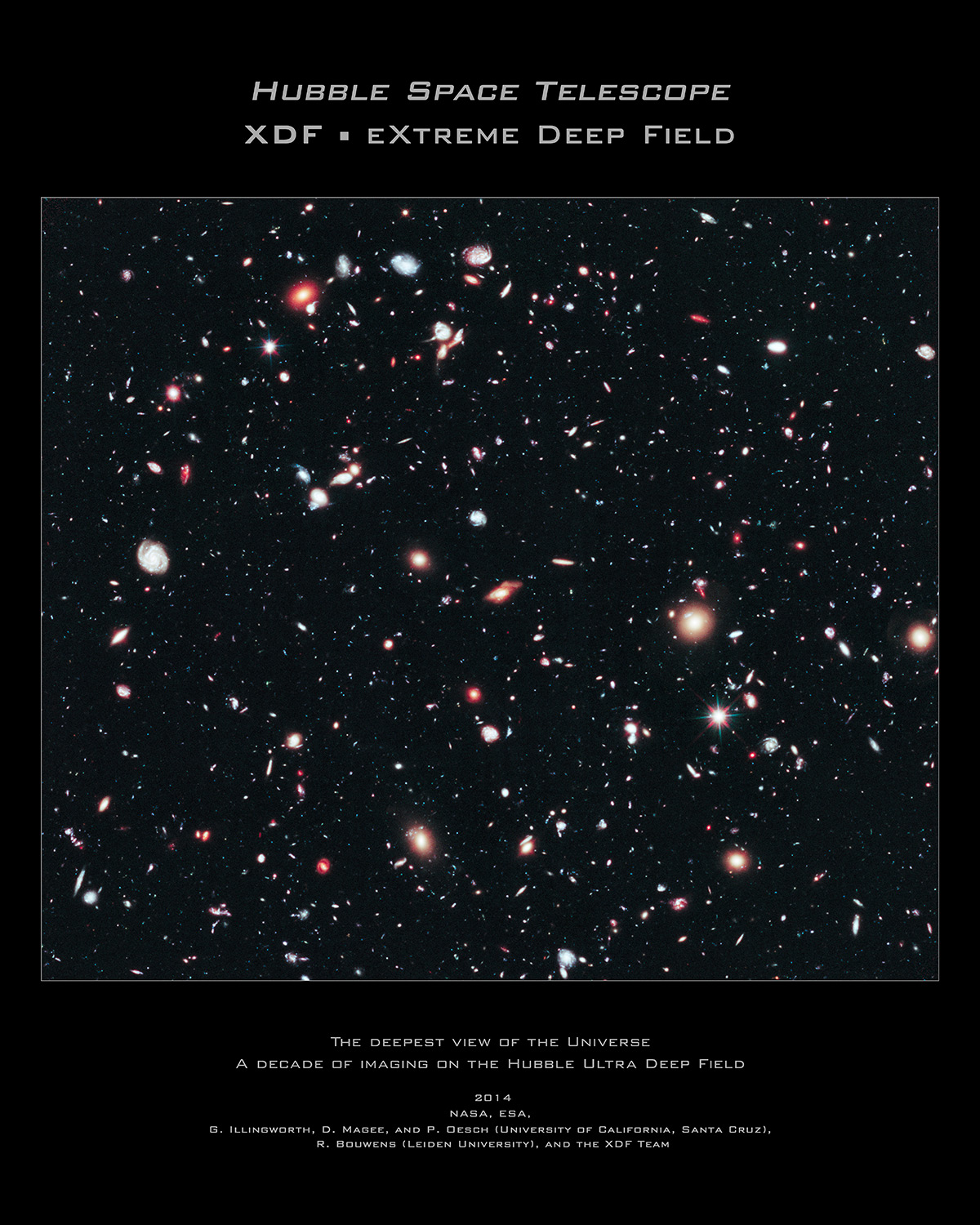
XDF Project Data Release
5 april 2013
The Hubble eXtreme Deep Field (XDF) team archived data products that include all optical and infrared data taken by Hubble covering the original Hubble Ultra-Deep Field (HUDF) program. The data used to generate the XDF were taken over the decade from mid-2002 to the end of 2012. The total exposure on the XDF is about 1.8 million seconds using data from Hubble's two main workhorse cameras, the Advanced Camera for Surveys Wide Field Channel (ACS/WFC) and the Wide Field Camera 3 InfraRed Channel (WFC3/IR). Substantial gains accrue from using all the ACS data taken over the decade since 2002, as well as from the improved processing techniques since the HUDF was released. The gains in the XDF are equivalent to adding about 180 orbits of data to the original HUDF dataset — split roughly equally between gains from improved processing techniques and from new data.
more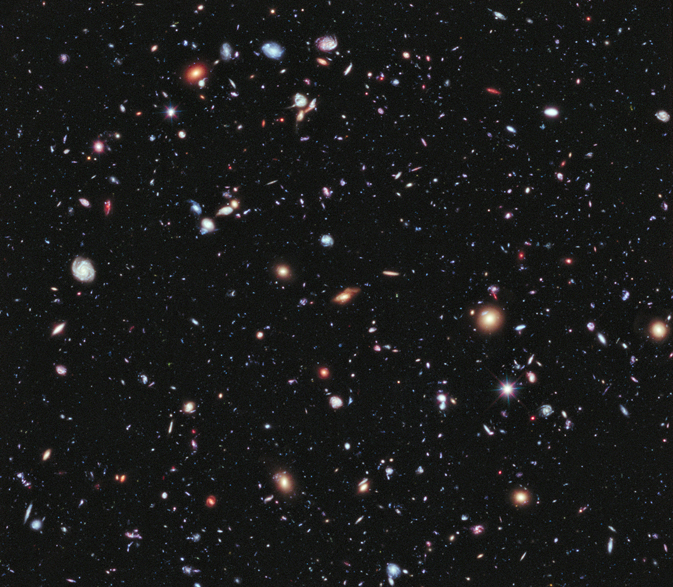
Hubble Goes to the eXtreme to Assemble Farthest-Ever View of the Universe
NASA
25 september 2012
Like photographers assembling a portfolio of best shots, astronomers have assembled a new, improved portrait of mankind's deepest-ever view of the universe. Called the eXtreme Deep Field, or XDF, the photo was assembled by combining 10 years of NASA Hubble Space Telescope photographs taken of a patch of sky at the center of the original Hubble Ultra Deep Field. The XDF is a small fraction of the angular diameter of the full moon.
more